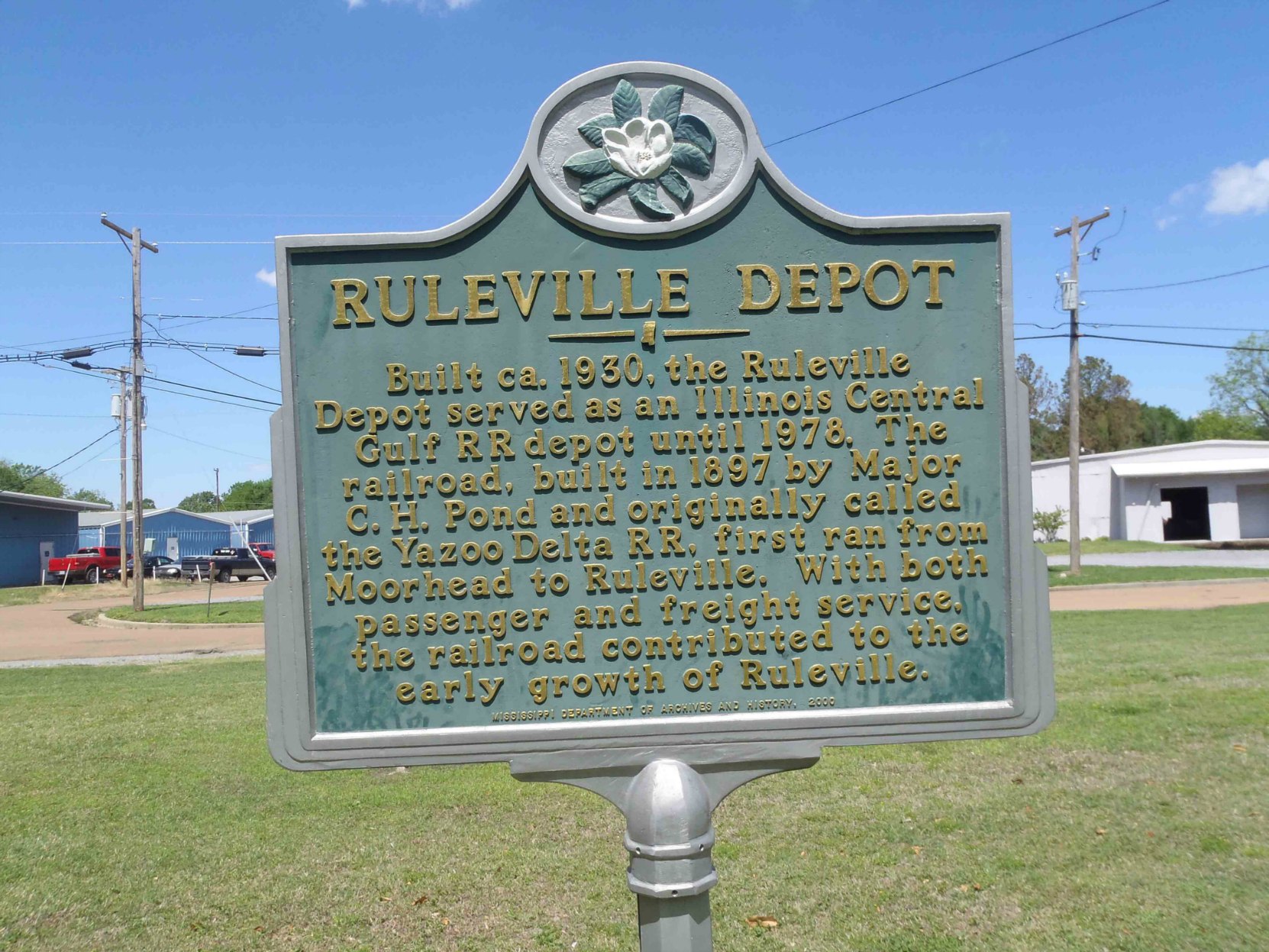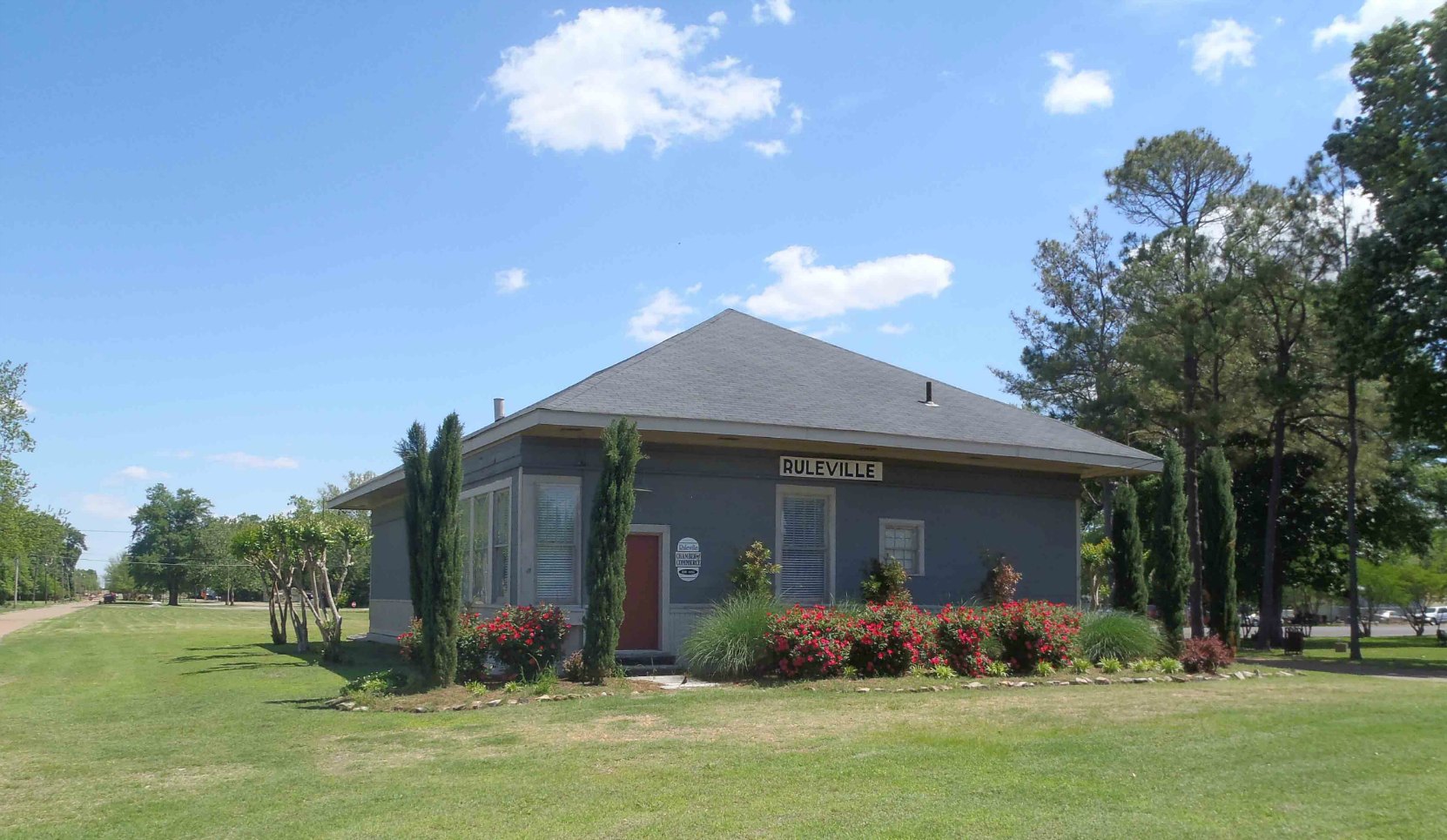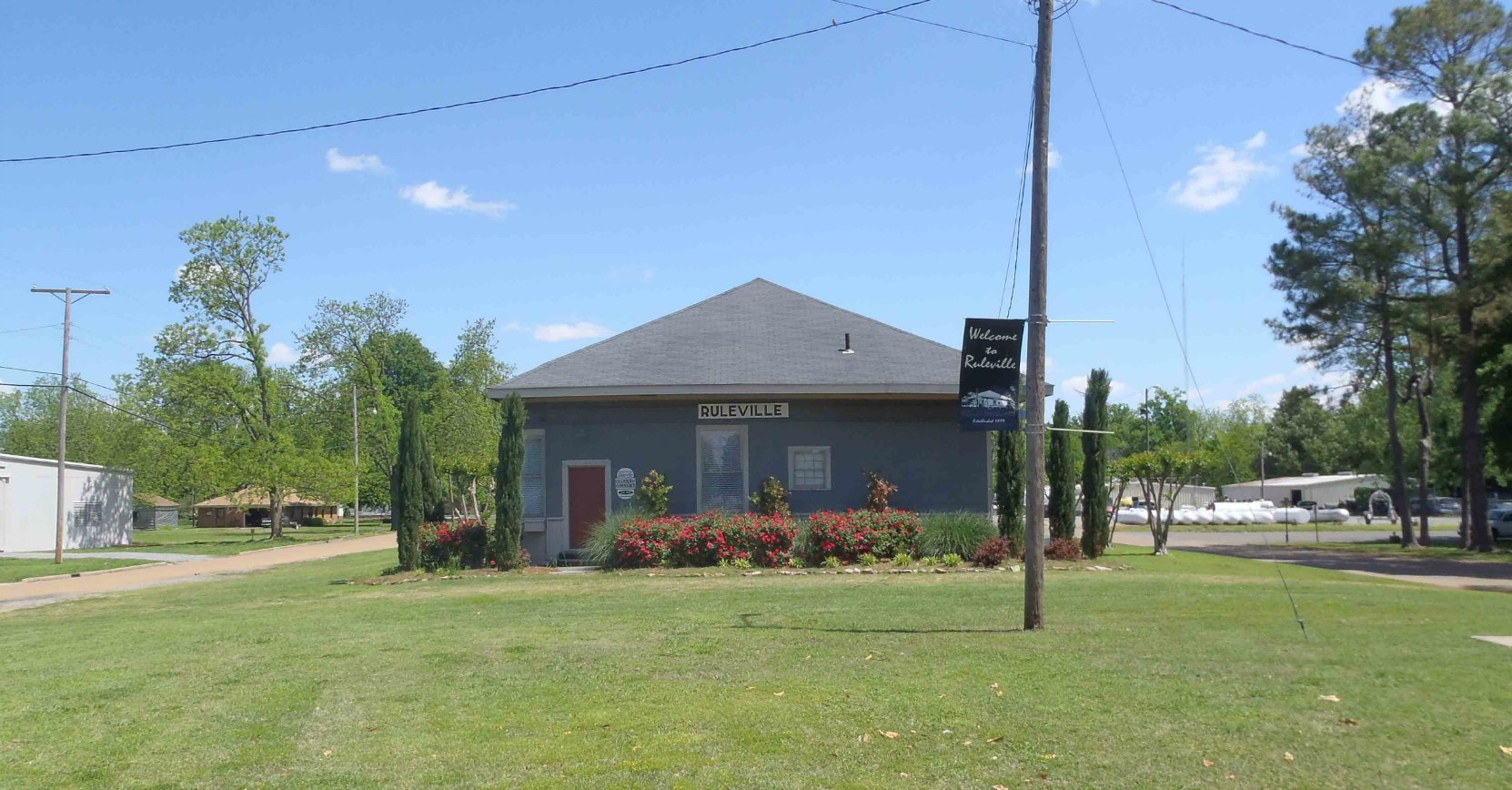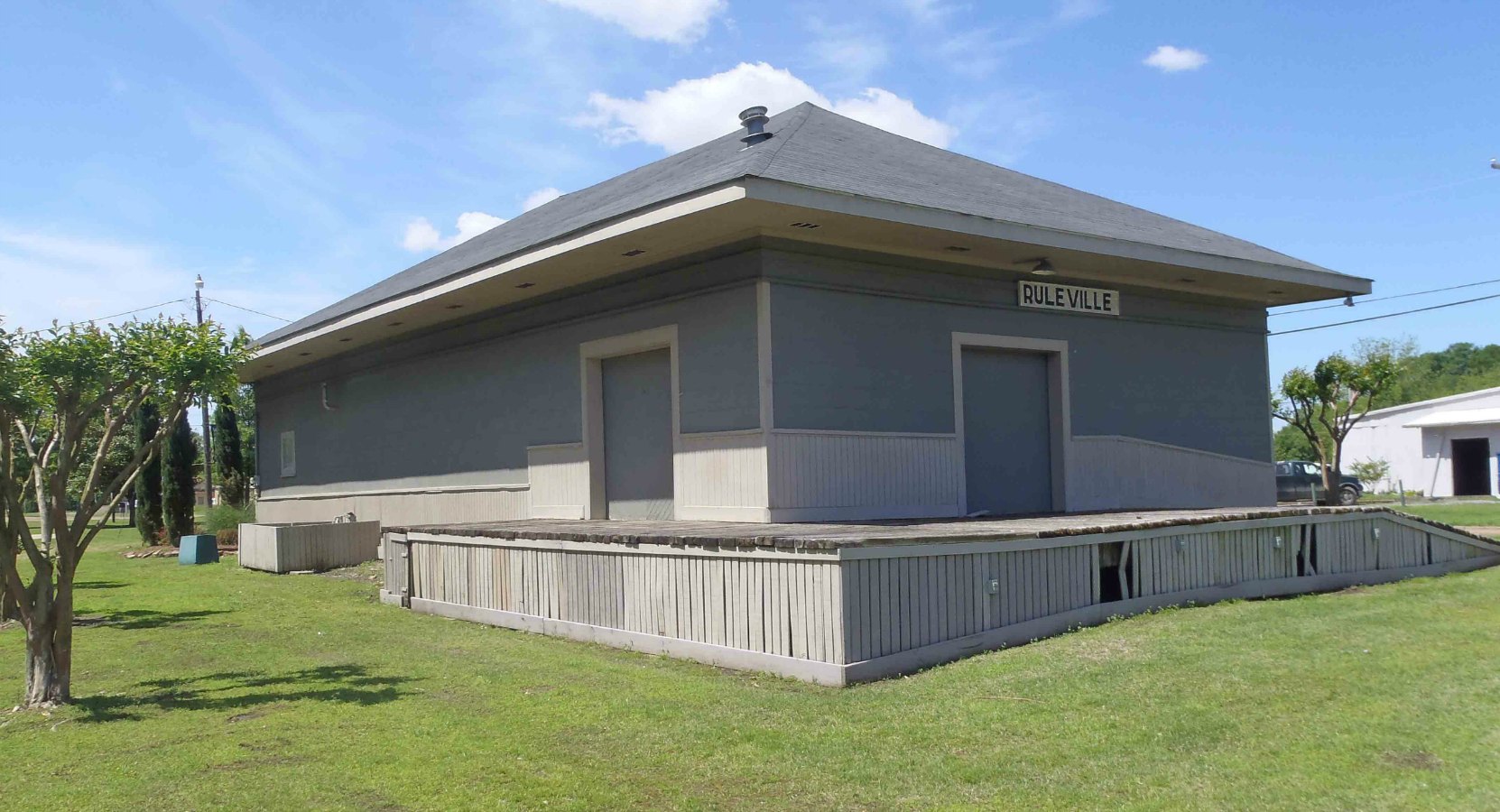This Mississippi Department of Archives and History marker was erected in 2000 on Front Street in downtown Ruleville, Mississippi.
There are also two Mississippi Blues Trail markers nearby commemorating Jimmy Rogers and Greasy Street. The GPS location of these markers are: N 33° 43.605′ W 90° 33.156′ and N 33° 43.599′ W 90° 33.181′

This marker reads:
“RULEVILLE DEPOT – Built ca. 1930, the Ruleville Rail Depot served as an Illinois Central Gulf RR Depot until 1978. The railroad, built in 1897 by Major C. H. Pond and originally called the Yazoo Delta RR, first ran from Moorhead to Ruleville. With both passenger and frieght service, the railroad contributed to the early development of Ruleville.”
As indicated on the marker, the railroad played a major role in the development of Ruleville. The Yazoo Delta Railroad was built in 1897 by Major C.H. Pond and originally ran between Inverness, Ruleville and Moorhead, Mississippi. The original Ruleville RR Depot was built in 1897 and rebuilt in 1913 after a tornado destroyed the building.
This railroad also has a significant place in American musical history; it’s nickname, the Yellow Dog, became part of the lyric in a well known W.C. Handy song, Yellow Dog Blues, which Handy registered for copyright in 1914.
The source of the Yazoo Delta RR‘s nickname of the “Yellow Dog” is uncertain. The Ruleville Depot National Historic Register designation says this nickname came about because the Yazoo Delta RR‘s s locomotives and rolling stock were constantly covered in yellow dust from the surrounding agricultural areas and because of the trains’ habit of regularly jumping jumping the tracks.
W.C Handy gives a different explanation of the origin of the nickname “Yellow Dog” in Chapter 6 of his autobiography. In W.C. Handy‘s version, a “blistering sun beats down upon a gang of black section hands during the late nineties [construction of the the Yazoo Delta began in 1897]. They are working down in Mississippi, laying the railroad tracks for the Yazoo Delta line between Clarksdale and Yazoo City. Their hammers rise and fall rhythmically as they drive the heavy spikes and sing ‘Dis ole hammer killed John Henry, won’t kill me. Dis ole hammer killed John Henry, won’t kill me.’
A locomotive, following the progress of the men, is steaming idly on the track. The letters ‘Y.D.’ are painted boldy on its coal car.
A travelling salesman comes up the embankment, mops the sweat from his face, shifts a chaw of tobacco from one bulging red cheek to the other, and says:
‘Hey, boy. What in tarnation does that Y.D. stand for?’
A Negro straightens up, rubs the kink out of his back and begins to scratch his head in obvious puzzlement.
‘H’m,’ he ventures slowly. ‘Yaller Dawg, I reckon.’
The strangers eyes twinkle. He cackles softly and walks on down the track. ‘Yaller Dawg,’ he repeats under his breath. ‘that’s pretty cute, hanged if it ain’t. Yaller Dawg. Gee whiz, that’s a good one.’ The Yazoo Delta R.R. was christened The Yellow Dog.
The story was circulated and the idea spread until one branch of of the Yazoo Delta was known as the North Dog. For reasons equally suggestive, the fast, direct train from Clarksville to Greenville was known as the Cannon Ball, while its slow-time, round-about companion between those points was called the Peavine. Negroes had nicknamed all those roads.”
Whatever the source of the nickname “Yellow Dog,” W.C. Handy used the name in his composition Yellow Dog Blues, which he copyrighted in 1914 and which featured the lyric, “I’m Going Where The Southern Cross The Dog“, referring to the rail intersection of Southern Railway with the “Yellow Dog” in Moorhead, Missisippi. The name “Yellow Dog” also figures in W.C. Handy’s story of his first hearing the blues in about 1903 at the railway station in Tutwiler, Mississippi. Here is a clip of Bessie Smith performing Yellow Dog Blues.
In 1930 the Illinois Central Gulf Railroad purchased the Yazoo Delta RR and built the Ruleville Depot which is now on the National Register of Historic Places. The Illinois Central ran two passenger trains and several freight trains through Ruleville each day until the 1950s, when passenger service was discontinued. Freight service was discontinued in 1978 and the Ruleville Rail Depot building was closed.

The Ruleville Depot building (shown above) remained vacant until 1987 when it was purchased by a Ruleville manufacturing company, which used it until 1996, when it was donated to the Ruleville Chamber of Commerce, which has used the Ruleville Depot as its offices ever since.
In 1999, the Ruleville Chamber of Commerce successfully applied to have the Ruleville Depot listed on the National Register of Historic Places.

The Ruleville Depot as is now appears. The railway tracks which formerly ran alongside the building were removed after the Illinois Central Railroad closed the rail line and the Ruleville Depot building in 1978.

The rear and side elevation of the Ruleville Depot showing what would have been the freight doors in the days the building was used as a railroad depot.
Would you like to leave a comment or question about anything on this page?